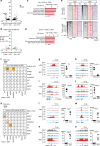A comprehensive map coupling histone modifications with gene regulation in adult dopaminergic and serotonergic neurons
- PMID: 29581424
- PMCID: PMC5964330
- DOI: 10.1038/s41467-018-03538-9
A comprehensive map coupling histone modifications with gene regulation in adult dopaminergic and serotonergic neurons
Erratum in
-
Author Correction: A comprehensive map coupling histone modifications with gene regulation in adult dopaminergic and serotonergic neurons.Nat Commun. 2018 Nov 2;9(1):4639. doi: 10.1038/s41467-018-07154-5. Nat Commun. 2018. PMID: 30389943 Free PMC article.
Abstract
The brain is composed of hundreds of different neuronal subtypes, which largely retain their identity throughout the lifespan of the organism. The mechanisms governing this stability are not fully understood, partly due to the diversity and limited size of clinically relevant neuronal populations, which constitute a technical challenge for analysis. Here, using a strategy that allows for ChIP-seq combined with RNA-seq in small neuronal populations in vivo, we present a comparative analysis of permissive and repressive histone modifications in adult midbrain dopaminergic neurons, raphe nuclei serotonergic neurons, and embryonic neural progenitors. Furthermore, we utilize the map generated by our analysis to show that the transcriptional response of midbrain dopaminergic neurons following 6-OHDA or methamphetamine injection is characterized by increased expression of genes with promoters dually marked by H3K4me3/H3K27me3. Our study provides an in vivo genome-wide analysis of permissive/repressive histone modifications coupled to gene expression in these rare neuronal subtypes.
Conflict of interest statement
The authors declare no competing interests.
Figures






References
Publication types
MeSH terms
Substances
LinkOut - more resources
Full Text Sources
Other Literature Sources
Molecular Biology Databases

